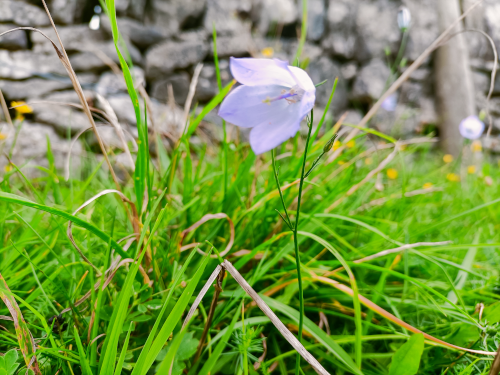Harebells are wild flowers with a beautiful blue colored bell-like flower that can be seen towards the end of the summer months.
Dancing Bells of the Wild
As you stroll through the serene landscapes of the Northern Hemisphere, you might chance upon a sight of delicate blue flowers swaying with the wind. These are none other than the Harebells, botanical name Campanula rotundifolia, an iconic wildflower that captivates botanists, ramblers, and casual nature lovers alike.
A Flower by Any Other Name
While most commonly known as Harebells, these flowers also answer to the names Bluebell (not to be confused with the similarly looking English Bluebell with the botanical name Hyacinthoides non-scripta), Witch’s Thimble, Witch’s Bells, Fairy Thimbles, Dead Man’s Bells, Aul Man’s Bells, and Lady’s Thimble in certain regions. But no matter the name, their mesmerizing charm and beauty remain consistent!
Painting the World in Shades of Blue
Geographical Spread: A Northern Star
Harebells are a proud feature of the Northern Hemisphere. These beauties are widespread across North America, Europe, and parts of Asia. From the rocky terrains of Scotland to the wide-open meadows of North America, they lend their color and grace to diverse landscapes.
Size
Elegance in Petite Frames
Typically, a Harebell grows to a height in the region of 20-40cm (about 8″ to 16″). They can stand tall despite their slender stems. Their spread is modest, usually around 20-30cm (approximately 8″ to 12″), making them perfect for compact wildflower clusters in the garden or on ornate rockeries.
The flowers can grown in singles, but are often found in clusters.

Seasonal Symphony – When to Spot Them
The best time to witness the splendor of Harebells is in mid to late summer, usually from about July to September. This is when they are in full bloom, adorning landscapes with their signature blue hue. If you are in certain parts of North America, you may be able to experience the delights of Harebells for even longer because they could bloom right from June to October.
Diving Deeper: The Science of Harebells
When it comes to the anatomy of the Harebell, each flower has a delicate bell shape, hence why sometimes referred to as Bluebells. The flowers are predominantly blue, but occasionally, you might encounter pale pink or white varieties. The plant’s leaves are thin and long, which earned it the botanical epithet “rotundifolia”, a somewhat ironic term given its long, slender leaves rather than round.
Regions of Resonance: Where They Call Home
While Harebells have a broad geographical range, there are specific regions where they particularly thrive.
- British Isles: Here, they’re often called the Scottish Bluebell. Contrary to its name, it is not limited to Scotland and can be seen across the British Isles. Not to be confused with the similarly looking English Bluebell with the botanical name Hyacinthoides non-scripta.
- North America: From the United States to Canada, the meadows are painted blue during peak Harebell season.
- Nordic Regions: The cooler climates of Scandinavia are perfect for Harebells. Their presence in these regions is a testament to their resilience and ability to thrive in diverse conditions.
Harebells and Folklore: A Mystical Connection
Over the ages, Harebells have inspired various myths and legends. The flower is believed to have mystical properties, and in some tales, it’s said that witches used the blooms to transform themselves into hares. While science might not back this claim, it does underline the deep cultural and emotional connection people have with this elegant wild flower.
Conservation Note
Though they are widespread, it’s essential to tread softly when you encounter these delicate wonders. Over-picking or trampling can affect local populations. Remember, the best way to enjoy nature is to leave it undisturbed, allowing future generations the same sense of wonder.
A Universal Charm
Whether you are a keen botanist, a lover of folklore, or simply someone who appreciates the beauty of nature, Harebells, with their simple elegance, hold universal appeal. As you explore the meadows and heaths of the UK, US and other countries in the Northern Hemisphere, keep an eye out for this blue-flowered beauty, a testament to nature’s ability to inspire and mesmerize all who behold it.
Thank you for visiting AboutPlants.com. We hope that you have enjoyed reading about Harebells (Campanula rotundifolia). Please let us know if there is any plant, flower, shrub or tree that you would like us to write about. If you have any articles of your own that you would like to have published on this website, please let us know by contacting us. Notice an error or omission? Again, please get in touch.